MicroRNA-30c inhibits human breast tumour chemotherapy resistance by regulating TWF1 and IL-11
- PMID: 23340433
- PMCID: PMC3723106
- DOI: 10.1038/ncomms2393
MicroRNA-30c inhibits human breast tumour chemotherapy resistance by regulating TWF1 and IL-11
Abstract
Chemotherapy resistance frequently drives tumour progression. However, the underlying molecular mechanisms are poorly characterized. Epithelial-to-mesenchymal transition has been shown to correlate with therapy resistance, but the functional link and signalling pathways remain to be elucidated. Here we report that microRNA-30c, a human breast tumour prognostic marker, has a pivotal role in chemoresistance by a direct targeting of the actin-binding protein twinfilin 1, which promotes epithelial-to-mesenchymal transition. An interleukin-6 family member, interleukin-11 is identified as a secondary target of twinfilin 1 in the microRNA-30c signalling pathway. Expression of microRNA-30c inversely correlates with interleukin-11 expression in primary breast tumours and low interleukin-11 correlates with relapse-free survival in breast cancer patients. Our study demonstrates that microRNA-30c is transcriptionally regulated by GATA3 in breast tumours. Identification of a novel microRNA-mediated pathway that regulates chemoresistance in breast cancer will facilitate the development of novel therapeutic strategies.
Figures
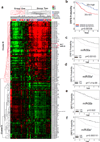
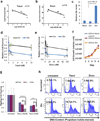
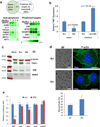

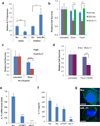
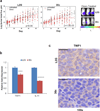
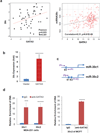
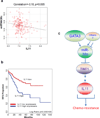
Similar articles
-
MicroRNA-30c targets cytoskeleton genes involved in breast cancer cell invasion.Breast Cancer Res Treat. 2013 Jan;137(2):373-82. doi: 10.1007/s10549-012-2346-4. Epub 2012 Dec 7. Breast Cancer Res Treat. 2013. PMID: 23224145 Free PMC article.
-
MicroRNA-30c inhibits pancreatic cancer cell proliferation by targeting twinfilin 1 and indicates a poor prognosis.World J Gastroenterol. 2019 Nov 14;25(42):6311-6321. doi: 10.3748/wjg.v25.i42.6311. World J Gastroenterol. 2019. PMID: 31754292 Free PMC article.
-
MicroRNA-486-5p improves nonsmall-cell lung cancer chemotherapy sensitivity and inhibits epithelial-mesenchymal transition by targeting twinfilin actin binding protein 1.J Int Med Res. 2019 Aug;47(8):3745-3756. doi: 10.1177/0300060519850739. Epub 2019 May 23. J Int Med Res. 2019. PMID: 31117868 Free PMC article.
-
Research Progress on Long Non-coding RNAs and Drug Resistance of Breast Cancer.Clin Breast Cancer. 2020 Aug;20(4):275-282. doi: 10.1016/j.clbc.2019.11.001. Epub 2020 Apr 30. Clin Breast Cancer. 2020. PMID: 32414649 Review.
-
MicroRNAs as a clue to overcome breast cancer treatment resistance.Cancer Metastasis Rev. 2022 Mar;41(1):77-105. doi: 10.1007/s10555-021-09992-0. Epub 2021 Sep 15. Cancer Metastasis Rev. 2022. PMID: 34524579 Free PMC article. Review.
Cited by
-
Downregulation of microRNA-30c-5p was responsible for cell migration and tumor metastasis via COTL1-mediated microfilament arrangement in breast cancer.Gland Surg. 2020 Jun;9(3):747-758. doi: 10.21037/gs-20-472. Gland Surg. 2020. PMID: 32775265 Free PMC article.
-
Multidrug-resistant breast cancer: current perspectives.Breast Cancer (Dove Med Press). 2014 Jan 10;6:1-13. doi: 10.2147/BCTT.S37638. eCollection 2014. Breast Cancer (Dove Med Press). 2014. PMID: 24648765 Free PMC article. Review.
-
Molecular mechanism for inhibition of twinfilin by phosphoinositides.J Biol Chem. 2018 Mar 30;293(13):4818-4829. doi: 10.1074/jbc.RA117.000484. Epub 2018 Feb 7. J Biol Chem. 2018. PMID: 29425097 Free PMC article.
-
MicroRNA-340-5p modulates cisplatin resistance by targeting LPAATβ in osteosarcoma.Braz J Med Biol Res. 2017 Apr 20;50(5):e6359. doi: 10.1590/1414-431X20176359. Braz J Med Biol Res. 2017. PMID: 28443990 Free PMC article.
-
Role of MicroRNA Regulation in Obesity-Associated Breast Cancer: Nutritional Perspectives.Adv Nutr. 2017 Nov 15;8(6):868-888. doi: 10.3945/an.117.015800. Print 2017 Nov. Adv Nutr. 2017. PMID: 29141971 Free PMC article. Review.
References
-
- Lu J, et al. MicroRNA expression profiles classify human cancers. Nature. 2005;435:834–838. - PubMed
-
- Bartel DP. MicroRNAs: genomics, biogenesis, mechanism, and function. Cell. 2004;116:281–297. - PubMed
-
- Fabian MR, Sonenberg N, Filipowicz W. Regulation of mRNA translation and stability by microRNAs. Annu Rev Biochem. 2010;79:351–379. - PubMed
Publication types
MeSH terms
Substances
Grants and funding
- U01 GM061393/GM/NIGMS NIH HHS/United States
- P01 CA075136/CA/NCI NIH HHS/United States
- P50 CA058223/CA/NCI NIH HHS/United States
- R21 CA139278/CA/NCI NIH HHS/United States
- CA 014599/CA/NCI NIH HHS/United States
- DK070103-05/DK/NIDDK NIH HHS/United States
- R01 CA100225/CA/NCI NIH HHS/United States
- R21 CA159066/CA/NCI NIH HHS/United States
- K12 CA139160/CA/NCI NIH HHS/United States
- P50 CA125183/CA/NCI NIH HHS/United States
- 1K12CA139160-02/CA/NCI NIH HHS/United States
- UL1 RR024999/RR/NCRR NIH HHS/United States
- P30 CA014599/CA/NCI NIH HHS/United States
- U01GM61393/GM/NIGMS NIH HHS/United States
- K99 CA160638/CA/NCI NIH HHS/United States
- U54 CA126524/CA/NCI NIH HHS/United States
- T90 DK070103/DK/NIDDK NIH HHS/United States
- 1R21CA159066/CA/NCI NIH HHS/United States
- K99 CA160638-01/CA/NCI NIH HHS/United States
- R01 CA104987/CA/NCI NIH HHS/United States
- P01 CA139490/CA/NCI NIH HHS/United States
- 5-P50-CA58223-17/CA/NCI NIH HHS/United States
- R00 CA160638/CA/NCI NIH HHS/United States
- U01 CA154209/CA/NCI NIH HHS/United States
- P50CA125183-05/CA/NCI NIH HHS/United States
LinkOut - more resources
Full Text Sources
Other Literature Sources
Medical
Molecular Biology Databases
Research Materials

